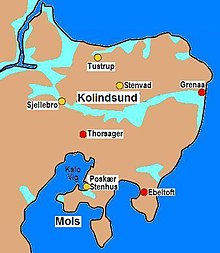Thorsø Høje
The Thorsø Høje ( German "Thorsinsel Hill" ) are 7.2 km northwest of Grenaa in the triangle between the villages of Dalstrup, Thorsø and Villersø on the East Jutland peninsula Djursland . There are nine remaining burial mounds from a large burial ground . The Djurslands Museum has excavated several of the now eroded mounds in recent years.
Most of the more than 25,000 preserved burial mounds in Denmark are isolated, as mounds in their vicinity have been eroded over time. The Thorsø Høje are an exception. You can clearly see how close the originally more than 30 burial mounds were to one another. The missing mounds of earth are mainly found on old maps.
Thorsø Høje are now visible hills in the landscape. This was not the case in the early 1990s, when the place was covered by almost impenetrable bushes. There is now an information board on the hill, south of the largest burial mound. "Melsækken" is a long mound that may contain several burials. Among the surrounding round hills, it is probably the oldest, as long hills usually date from the Neolithic period, while most of the round ones date from the subsequent Bronze Age (1,800–500 BC). It is a hill of the "Konens Høj type" (women's hill - named after a place where it was found) from the beginnings of the Danish Neolithic (around 3750–3500 BC).
The amateur archaeologist Lieutenant J. Jensen (1845-1909) carried out the first excavation in 1867, during which he excavated seven burial mounds in one week. In one he found a stone box , but otherwise there are no findings or indications from the excavation, which may have been carried out on behalf of private collectors.
In 1893 and 1894, south of today's group of hills, two mounds that have since been removed were examined by the National Museum. Three urns with corpses and a fragment of a bronze ring were found. The imprint of a stye could be seen in the clay of one of the urns. In the second hill two were daggers of flint and a massive bronze ax with the remains of the stem. There are also readings of prehistoric artifacts from the Stone, Bronze and Iron Ages in the region . In 1937 the owner of the field south of the hills found a fine bronze sword with a wooden sheath, which he gave to the National Museum.
In 1938 the National Museum examined "Melhøj" on the burial ground. The owner found two graves while the hill was being cleared. During the excavation, three hearths from the Early Late Bronze Age, around 1000 BC, were found. BC, and burnt bones were found. Among the graves examined was one of the women buried with a rich set of bronze jewelry: arm, finger, neck rings, belt plates and needles. The graves also contained well-preserved remains of textiles, such as woven clothing with brass buttons.
Some of the finds can be seen in the Djurslands Museum in Grenaa. The exhibition also includes eight bronze swords from a field near Dystrup, a discovery made in 1994, 10 km west of Thorsø Høje.
literature
- Aarhus Office: På tur i Djurslands Fortid .
- Ingrid Falktoft Anderson: Vejviser til Danmarks oldtid. 2nd Edition. Gads Forlag, Århus 1994, ISBN 87-89531-10-8 , p. 162.
- Jakob Vedsted: Fortidsminder og Kulturlandskab - en kildekritisk analysis af tragtbaegerkulturens found material from northern Jursland. Forlaget Skippershoved, Ebeltoft 1986. ISBN 87-981329-5-4
Individual evidence
- ^ "Konens Høj" -type systems or Niedźwiedź-type (NTT) systems - a site south of Krakow in Poland - are (apart from earthworks ) in some regions of the large TBK area the earliest cult system architecture of the funnel mountain culture .
Web links
Coordinates: 56 ° 27 ′ 6.1 ″ N , 10 ° 49 ′ 50 ″ E
